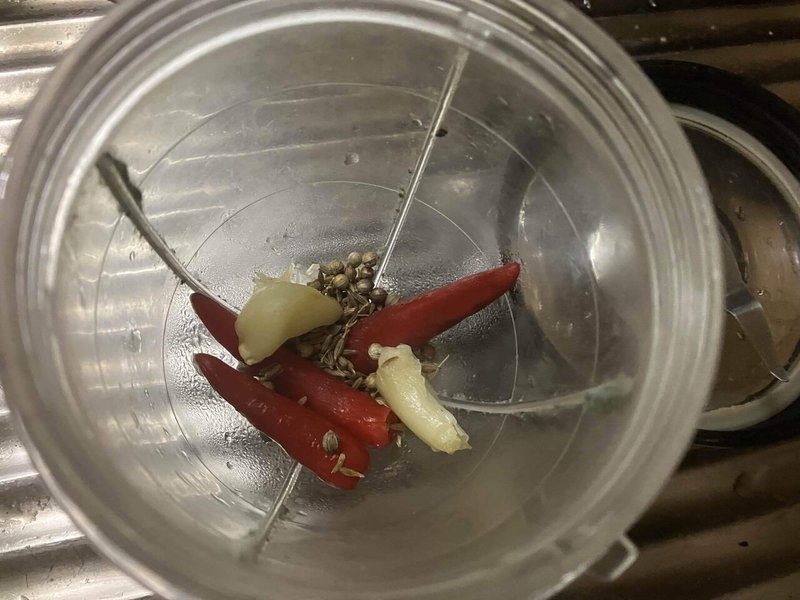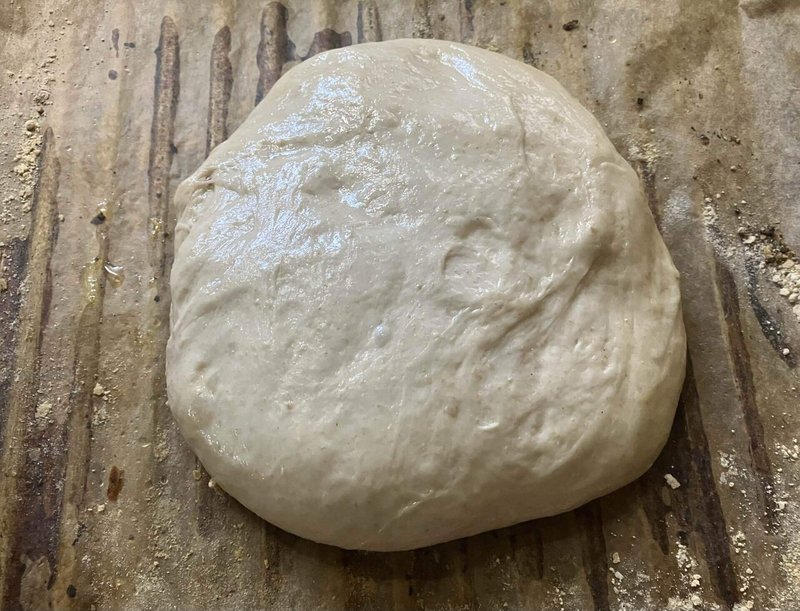
海を超えて出会った茄子とトマトから生まれたザアルーク Zaaluk: Eggplant and tomato meet across the sea
ときどきベジタリアン
I'm a vegetarian sometimes
ストーリー
Recipe trivia
茄子は古い野菜だ。同じナス科のトマト、唐辛子やパプリカ、じゃがいもなどが新大陸から15世紀に持たらされた比較的新しい野菜であるのと比べると、旧大陸において、茄子は非常に長い栽培の歴史を持っている。茄子は南アジア原産と言われる熱帯性の多年草で、温帯には自生しない。しかし、紀元前四千年頃にはその栽培の痕跡があったという研究もあり、インドやメソポタミアでは紀元前から畑で一年草として広く栽培されていた。現在でも中近東から地中海で最も広く食べられている夏野菜の一つに数えられる。ただ、欧州では当初は知られていなかった。中世に、イスラム帝国、そしてオスマン帝国が版図を地中海まで広げたのに伴って、地中海沿岸でも茄子は常食されるようになったと考えられる。
Eggplant is an old vegetable. Compared to tomatoes, chili peppers, paprika, and potatoes, which are from the same Solanaceae family and are relatively new vegetables that were brought over from the New World in the 15th century, eggplant has a very long history of cultivation in the Old World. Eggplant is a tropical perennial plant that is said to be native to South Asia and does not grow naturally in temperate regions. However, some research has found traces of its cultivation around 4000 BC, and it was widely cultivated as an annual plant in fields in India and Mesopotamia before the Common Era. Even today, it is counted as one of the most widely eaten summer vegetables from the Middle East to the Mediterranean. However, it was not known in Europe at first. It is thought that eggplant became a common food in the Mediterranean coast as the Islamic Empire and then the Ottoman Empire expanded their territories to the Mediterranean in the Middle Ages.
イスラム帝国のアフリカにおける支配の最西端はマグレブ(日の没する国)で、ここを足がかりに、ジブラルタル海峡を渡り、イスラム勢力はイベリア半島まで支配を広げた。マグレブ諸国の最西端が今の「モロッコ」だ。元々はカルタゴ人やベルベル人が住む王国だったが、カルタゴが戦争に負け、最終的にローマ帝国の属州に編入された。その後イスラム帝国に征服され、イスラム教国となった。その後何度も侵略されたが、17世紀以降は、ムスリムの国として、今の王統が続いている。
モロッコでよく食べられている茄子料理が、この「ザアルーク」。茄子を焼いたり揚げたりしてペーストにして食べる料理は、イスラム帝国やオスマン帝国によって各地に伝えられ、今ではすっかり地中海料理の一角をなしている。オスマン帝国の支配地だった地域で前菜に出てくる「ババガヌーシュ」や「ムッタバル」が茄子が主体であるのに対し、この「ザアルーク」はトマトがたくさん加えられている。フランスの「ラタトゥイユ」やイタリアの「カポナータ」にも似ている。おそらく、かつてはイスラム勢力に征服されたスペインにもこの手の茄子料理が伝わって「ピストマンチェゴ(カポナータの原型となったと言われるスペイン料理」」が作られ、イタリアやフランスに伝わったと考えることもできそうだ。その後、スペインが大航海時代に新大陸から持ち帰ったトマトが普及するのに伴って、ナスとトマトのコンビネーションが生まれ、逆に、モロッコや欧州の商人がオスマン帝国にトマトを伝えて、オスマン帝国の宮廷料理にも影響を与えたとも考えられる。ザアルークは、そんな想像を掻き立ててくれる一品だ。
The westernmost part of the Islamic Empire's control in Africa was the Maghreb (Land of the Setting Sun), and using this as a foothold, the Islamic forces crossed the Strait of Gibraltar and expanded their control to the Iberian Peninsula. The westernmost country in the Maghreb is present-day Morocco. It was originally a kingdom inhabited by the Carthaginians and Berbers, but after Carthage lost a war, it was eventually incorporated into a province of the Roman Empire. It was later conquered by the Islamic Empire and became an Islamic country. It was invaded many times after that, but since the 17th century, it has continued as a Muslim country under the current royal line.
Za'alouk is a popular eggplant dish in Morocco. This dish, which is made by baking or frying eggplant into a paste, was introduced to various places by the Islamic Empire and the Ottoman Empire, and is now a part of Mediterranean cuisine. In areas under the control of the Ottoman Empire, appetizers such as baba ghanoush and muttabar are mainly made of eggplant, but za'alouk contains a lot of tomatoes. It is similar to the French "Ratatouille" and the Italian "Caponata". Perhaps this type of eggplant dish was introduced to Spain, which was once conquered by Islamic forces, and "Pisto Manchego (a Spanish dish said to be the prototype of Caponata)" was created, and it could have been introduced to Italy and France. Later, as tomatoes brought back from the New World by Spain during the Age of Discovery became widespread, the combination of eggplant and tomato was born, and conversely, it is thought that merchants from Morocco and Europe introduced tomatoes to the Ottoman Empire, influencing the Ottoman court cuisine. Zaalouk is a dish that stirs up such imagination.
ちょうど、プランターに植っている茄子の収穫があり、毎日豊作のミニトマトでペーストも作ってあったので、それを使って作った。
この料理を食べると、もう40年前の話で、ご存命ではないのだが、僕のアラビア語の先生を思いだす。結局、アラビア語はものにならなかったけど、彼の博識と穏やかな語り口を今でも思い出す。彼のラテン語やギリシャ語にまで及ぶ語学力と読書量、洞察力は尊敬に値した。僕はアラビア語は落第生だったけど、彼は僕の人生の最高の先生の一人だった。彼はベルベル人がであることに誇りを持ち、思索を極めた偉人だった。モハメド先生ありがとう!
I had just harvested eggplants from a pot and had made some tomato paste, so I used that to make this.
I had just harvested eggplants from a planter, and had made some tomato paste, so I used that to make this dish.
When I eat this dish, I am reminded of my Arabic teacher, who is no longer alive and was 40 years ago. In the end, I never mastered Arabic, but I still remember his vast knowledge and gentle way of speaking. His language skills, which extended to Latin and Greek, his amount of reading, and his insight were worthy of respect. I was a poor student at Arabic, but he was one of the best teachers of my life. He was a great man who was proud to be Berber and a great thinker. Thank you, Teacher Mohammed!
Ingredients:
材料:
なす
自家製トマトペースト(トマトの水煮や生でも良い)
にんにく
生の唐辛子(チリパウダーや乾燥唐辛子でも良い)
レモン
クミンシード(クミンパウダーでも良い)
コリアンダーシード(コリアンダーパウダーでも良い)
パセリかフレッシュコリアンダー
自然塩
Eggplant
Homemade tomato paste (boiled or fresh tomatoes are fine)
Garlic
Fresh chili peppers (chili powder or dried chili peppers are fine)
Lemon,
Cumin seeds (cumin powder is fine)
Coriander seeds (coriander powder is fine)
parsley or fresh coriander
Sea salt
procedure:
手順:
,(辛味調味料を作る)
生の唐辛子、焼いて皮を剥いたニンニク、クミンシード、コリアンダーシード、レモン汁を小型のブレンダーに入れるか、すり鉢ですり潰す。潰しにくければ、レモン汁を足すと、潰しやすい。
パプリカパウダーに熱したオリーブオイルを注ぎ、混ぜてペースト状にして、すり潰したペーストに加えて、さらによく混ぜる。
大体全ての材料が同じ重量比。
ここまでを前もって作っておいても良い。
(Making a hot seasoning)
Put raw chili peppers, roasted and peeled garlic, cumin seeds, coriander seeds, and lemon juice into a small blender or crush in a mortar. If it's difficult to crush, add lemon juice to make it easier.
Pour hot olive oil into the paprika powder and mix to make a paste, then add to the crushed paste and mix well again.
All ingredients are roughly equal in weight ratio.
You can prepare this in advance.




(ザアルークを作る)
茄子を焼き網で焼くか、グリルやオーブンで焼く。焦げても構わない。
十分に柔らかく焼けたら、冷まして、スプーンなどで身を掻き出す。焼いた直後に紙袋に入れて冷ませば、皮を取りやすくなる。
鍋に、焼いたナスの身を入れ、加熱して水分を飛ばす。そこにトマトペーストと前工程で作った辛味調味料を好みの量入れて、ペースト状に練り、火を止める。生や水煮のトマトを使う場合は、茄子と同じタイミングで鍋に入れ、茄子と一緒に煮て水分を飛ばす。
ペーストをさらに盛り、オリーブオイルやパセリの葉、コリアンダーの葉などを飾る。黒オリーブを飾っても良い。
(Making zaaluk)
Grill the eggplants on a wire rack, or in a grill or oven. It's okay if they burn.
When they are cooked and soft enough, let them cool and scrape out the flesh with a spoon. If you cool them in a paper bag immediately after cooking, it will be easier to remove the skin.
Put the grilled eggplant flesh in a pot and heat to remove the moisture. Add tomato paste and the desired amount of the spicy seasoning made in the previous step, mix into a paste, and turn off the heat. If using raw or boiled tomatoes, add them to the pot at the same time as the eggplant and simmer together with the eggplant to remove the moisture.
Put more paste on top and garnish with olive oil, parsley leaves, coriander leaves, etc. You can also garnish with black olives.







Tips and tricks:
コツと応用のヒント:
この辛味調味料は、北アフリカでよく使われるチュニジア発祥の調味料「ハリッサ」と構成が似ているので、ここまでの工程を省略して、市販のハリッサで代用しても良い。タジン鍋やクスクスなど、北アフリカ料理がお好きなら、まとめて作っておいて、逆に手作りハリッサとしての活用もできる。冷蔵庫で2、3ヶ月ほど保存が可能。その場合は必ず焼いたニンニクを使うこと。生ニンニクをそのままを使うと、酸化してすぐ劣化してしまう。
モロッコ料理はお隣のアルジェリア料理やチュニジア料理ほどは辛くしない。辛味調味料の量は少なめにするか、横に添えて味を調節できるようにすると良い。
パプリカは生が手に入る季節なら、茄子と同様に焼いてから、潰しても良い。ここでは季節ではないのでパウダーを使った。
米茄子の場合は、焼くと時間がかかるので、急ぐなら、油で揚げても構わない。
写真の盛り付けには緑のオイルが使われているが、これは自家製のパセリオイル(レシピはまたの機会に紹介する予定)。
This hot seasoning has a similar composition to "harissa," a seasoning originating from Tunisia that is commonly used in North Africa, so you can skip this step and use commercially available harissa instead. If you like North African cuisine such as tagine or couscous, you can make a large batch and use it as homemade harissa. It can be stored in the refrigerator for about 2 to 3 months. In that case, be sure to use roasted garlic. If you use raw garlic as is, it will oxidize and deteriorate quickly.
Moroccan cuisine is not as spicy as neighboring Algerian and Tunisian cuisine. It is best to use less hot seasoning or to serve it on the side so you can adjust the flavor.
If fresh paprika is available in season, you can roast it and then mash it, just like with the eggplant. Since it is not in season here, I used powder.
In the case of rice eggplant, it takes a long time to bake, so if you are in a hurry, you can fry it in oil.
The green oil used for the arrangement in the photo is homemade parsley oil (the recipe will be introduced on another occasion).
このペーストはパンと非常によく合う。フランスパンに乗せたり、ピタパンに挟んでも良いけど、モロッコ流の平焼パンに添えても良い。
前の記事で紹介した「冷蔵庫に常備する発酵生地」を使っても焼けるので、自分で焼くなら参考にして欲しい。
This paste goes very well with bread. You can put it on French bread, put it in a pita bread, or even serve it with Moroccan flatbread.
You can also bake it using the "fermented dough you always keep in the fridge" that I introduced in my previous article, so if you're baking it yourself, please use that as a reference.


Guide to where to get ingredients and equipment 材料と機材の入手先ガイド
※Amazonのアフェリエイトに参加しています。もしご購入の際はここからクリックしてご購入いただけると、コーヒー代の足しになるので、嬉しいです。ちなみに僕はコーヒー依存症です。
*I participate in Amazon affiliate programs. If you purchase this product by clicking here, it will help pay for my coffee, so I would be very happy. By the way, I am addicted to coffee.
この記事が気に入ったらサポートをしてみませんか?

